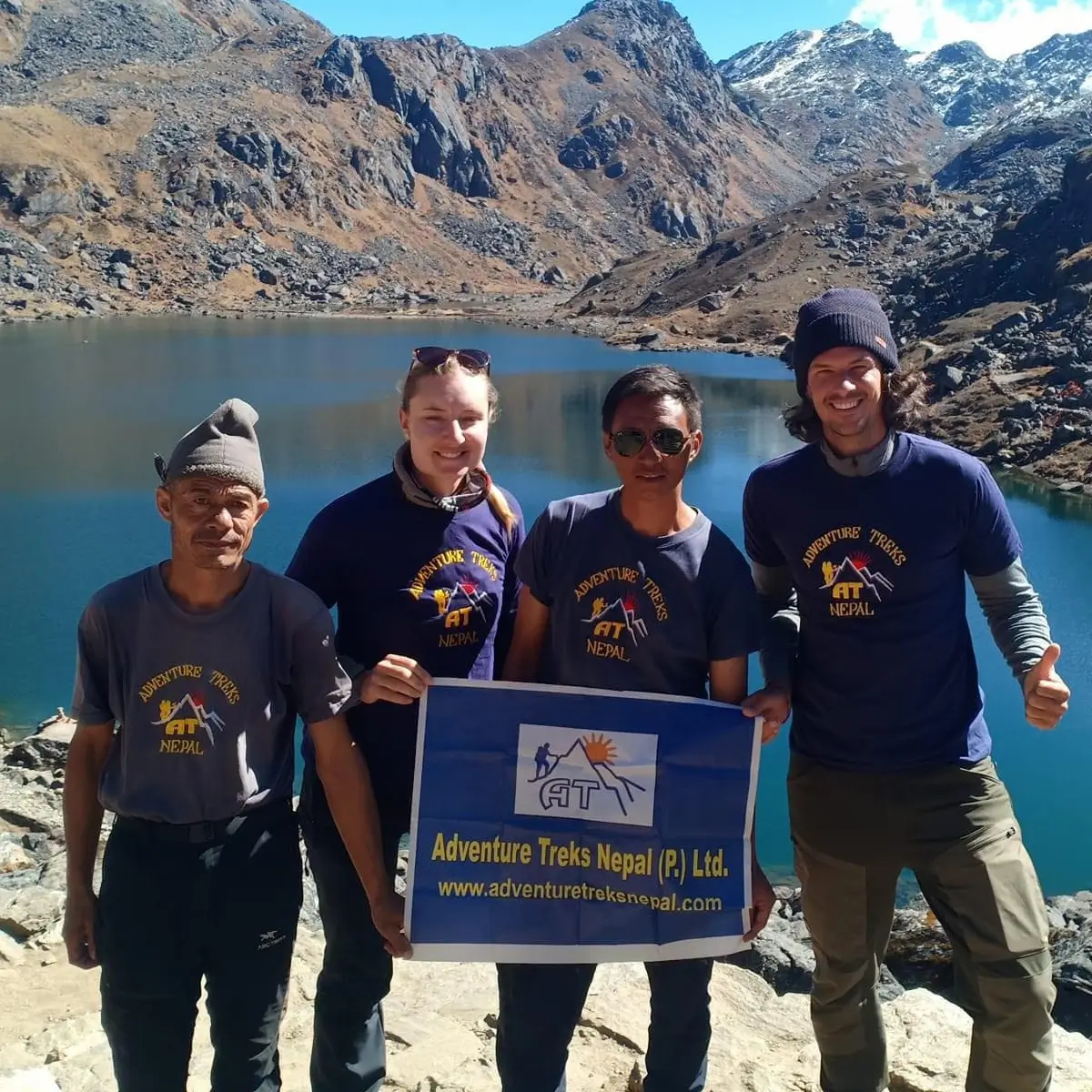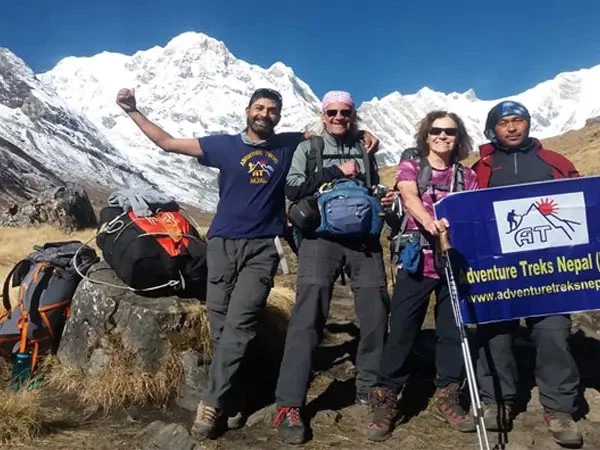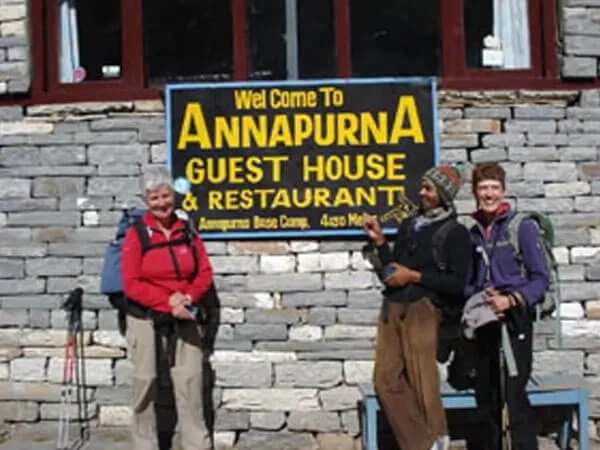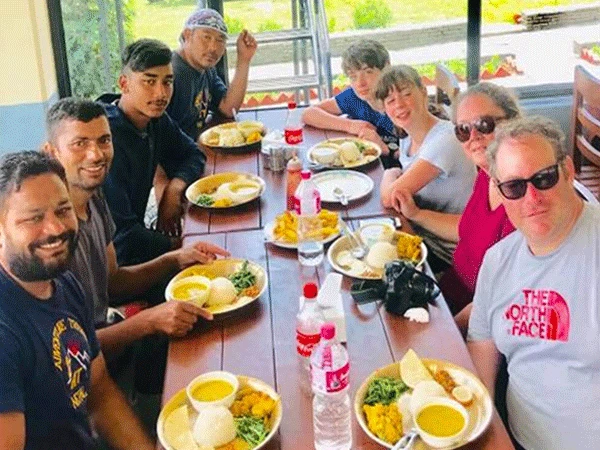Why is Langtang Valley a Hidden Gem of Nepal?
The Langtang Valley Trek is for those enthusiastic trekkers who want a short journey that can be accomplished with family, including children and aged people, at a lower altitude than other famous high-altitude trekking in Nepal. The Langtang region is not only naturally rich, but you can also indulge in local traditions and cultures. We mention some reasons below why Langtang Valley is a hidden gem of Nepal:
Diverse Landscape along the trails
Leaving the Kathmandu Valley behind, you embark on an enthralling and picturesque road trip from Kathmandu to Syabrubesi, Rasuwa, which takes you to the heart of the Langtang region. The walk winds through the Langtang River, alpine meadows, and glacial rivers, traversing various villages and verdant forests with rhododendrons and bamboo shrubs. You become enmeshed in its allure as you explore the Langtang Glacier and its glacier lakes.

Stunning Himalayan Views
Throughout the journey, the Langtang Valley trekking route is lesser known and remains peaceful, unlike the hectic paths of Annapurna and Everest. Even though some sections of the trek are remoter and off the beaten route, you are treated to stunning panoramas of Langtang Lirung (7324 m), Langtang Ri (7205 m), Yala Peak (5520 m), Tserko Ri (5000 m), Dorje Lakpa (6966 m), Kyanjin Ri (4773 m), etc. In addition, it creates an ideal retreat for trekkers seeking peace and connection with nature. Besides this, one of the major keys during the Langtang Valley Trek is the exciting ascent to Tserko Ri for spectacular sunrises over mountain ranges.
Wildlife encounters in Langtang National Park
During this adventurous Langtang Valley Trek, you walk most of the trails through Langtang National Park, which has an area of 1,710 sq. km. and is home to a wide range of flora and fauna. Here, you can encounter 46 species of mammals, 84 species of fish, 70 species of butterflies, 370 species of birds, and 3,128 species of flowers. Especially, you may have glimpses of rare animals for instance, snow leopards, red pandas, Himalayan black bears, etc. Vegetations such as rhododendrons, oaks, maples, birches, junipers, etc. decorate the dense forest of the national park.

Unique Cultural Experiences
Adequate information regarding cultural experiences throughout the trip is another feature that should not be missed in the Langtang Valley Trekking Guide. More than eighty percent of local inhabitants are of the Tamang community, which has unique traditions and cultures with distinct customs, language, script, and ethnic instruments. They speak the Tamang language, which comes from the Tamanic branch of the Tibeto-Burman language family. They celebrate Sonam Lhosar as the major festival. Their popular cultural dance is Tamang Selo.
Similarly, you can explore the unique integration of Tamang and Tibetan culture, especially influenced by Tibetan Buddhism, which flourishes in the Himalayas. It is the perfect chance to obtain divine favor at old Buddhist monasteries and gompas such as Kyanjin Gompa and Langtang Gompa. Similarly, you will effortlessly immerse yourself in nature and culture.
What should other things be expected during the Langtang Valley Trek?
Langtang Valley trekking is an off-the-beaten-path trek in Nepal that offers you a unique experience within a very short period. Even though you spend your days in isolated areas, you may have basic facilities during the trek. Some expected services are given below at the points on the trek.

Accommodation and Food on the Trek
Although the Langtang trekking trail passes through isolated locations, you can still find warm, welcoming teahouses with simple but adequate rooms and warm blankets. Basic amenities are available here, such as hot showers at specific locations. You may get organic Nepalese dishes, including dal bhat, momos, and noodles at teahouses. Several restaurants may serve you western snacks, soups, and other delicious dishes.
Langtang Trails Conditions
Langtang Trail is one of Nepal's shortest and finest trekking routes, offering a great opportunity to immerse oneself in unique culture and nature’s charm. The standard route of the Langtang Valley Trek climbs a narrow valley along the Langtang River. The road is in poor shape, partially gravel, and undergoing continuous construction. Buses travel slowly and stop frequently, and passengers board and disembark, which is a common bus journey in Nepal.
In 2015 A.D., Langtang Village was completely devastated by an earthquake, but you will get essential facilities now in the reconstructed teahouses, lodges, and hotels. Despite this damage, the trail is still adorned with panoramic views of majestic peaks such as Langtang II, Langtang Lirung, etc, and a perfect budget-friendly trekking in Nepal Under $1000.

Duration
Generally, the Langtang Valley Trek is completed within 7 to 11 days, depending on the customized itinerary. It is a shorter yet rewarding journey, among other popular treks in Nepal that are lesser-known and nearest to Kathmandu Valley, just 123 km away. It is a Short Trek for Families in Nepal, which can be a cheaper, shorter, and more promising excursion than other treks such as the Annapurna Base Camp Trek, Annapurna Circuit Trek, or Everest Base Camp Trek.
The Best Seasons to explore Langtang Valley Trekking Route
If you pack well and prepare physically and mentally, the Langtang Valley Trekking Guide suggests you visit it in any season. However, the spring and autumn seasons are the best time for the Langtang Valley Trek of the year to explore there. Hiking is suitable during these seasons, as you can witness breathtaking snow-covered mountains with crystal-clear skies and pleasant temperatures. The time offers the best setting for an amazing trek while enjoying blooming wildflowers in the clean mountain atmosphere.
Autumn( Sep-Dec)
The first three months of the dry season, from mid-September to mid-December, are the optimal period of year to trek in Nepal's Himalayan region. Since the weather is still warm and the mountain peak is becoming more stunning, this is also the best time for the Langtang Valley Trek. Because of the monsoon rains, the sky is clearer during this time. Even though the path becomes icy and chilly in December, January, and February, some hikers would still like to explore this tranquil valley because these months are also suitable for hiking. Even so, the trip is always beneficial with the Langtang Valley Trekking Guide because it is less difficult than other treks and has a reduced danger of altitude sickness.
Spring ( Feb-May)
In the spring season, various beautiful flowers blossom, making the Langtang Valley Trekking route fragrant with their essence. Moreover, the weather becomes drier from March to May, and dust begins to linger in the air, reducing the quality of Himalayan views but blooming wildflowers such as rhododendrons compensate for it. Despite this, it’s the best time for the Langtang Valley Trek.
What Should You Pack for the Langtang Valley Trek?
Even though the best periods of the year to hike into the Langtang Valley trekking route are autumn and spring, you will have a lot of fun in the winter and monsoon seasons too if you pack well with physical fitness and mental preparation. While you are planning a short trek for families in Nepal, it could be challenging to pack for a trip, as you want to take every essential thing but you are also unwilling to overpack and haul a bulky suitcase for long days.
With proper preparation, anyone can comfortably complete the approximately 62 km trek. Some emergency supplies are required for trekking in the Langtang Valley.
Trekking Clothing: Base layers, insulating layers, outer layers, Trekking Pants, T-shirts, Gloves, Socks, a warm hat, a Buff/scarf, a down jacket,
Footwear: Hiking Boots, Sandals, or Camp Shoes
Sleeping Essentials: Sleeping Bags, Sleeping Bag Liner
Trekking Gear: Backpack (30-40L), trekking poles, headlamp
Personal Items: Water Bottles, Water Purification, Snacks, Sunscreen and Lip Balm, Sunglasses, First Aid Kit, waterproof bags
Documents and Permits: Langtang National Park Entry Permit, Trekking Information Management System ( TIMS) Card, Passport, and copies
Miscellaneous Essentials: Smartphone, power bank, toiletries, towel, notebook, and pen
Optional Options: Gaiters, a lightweight blanket, maps, or a GPS device.

Langtang Valley Trekking Plan: Best Routes and Highlights
Day 1: Arrival in Kathmandu Valley (1350 m) and transfer to hotel and preparation for the trek
Upon your arrival day, you will attend a welcome dinner organized by our team, where you will meet your guide and fellow trekkers. The guide will brief the itinerary that assists you in preparing for the trek.
Day 2: A thrilling drive to Syabrubeshi (1550 m): 6 to 7 hours
Your journey begins with a scenic drive passing through Trishuli Bazar, Dhunche, and then reaching Syabrubeshi. At Dhunche, your permit for entering Langtang National Park will be verified.
Day 3: Trek to Lama Hotel (2380 m): 6 to 7 hours
Listening to the sound of the Langtang River and crossing several suspension bridges, you reach the Lama Hotel, a group of hotels and lodges.
Day 4: Trek to Langtang Village 6 to 7 hours
You arrive in Langtang Village after trekking through terraced fields, quaint settlements, traditional chortens, mani walls, water mills, and prayer wheels.
Day 5: Trek to the historically significant monastery, Kyanjin Gompa (3870 m) : 3 to 4 hours
Finally, you reach Kyanjin Gompa, one of the major features of the trek walking through Lantang National Park. On the way, you may encounter unique wildlife and vegetation while enjoying the majestic vistas of Langtang Lirung, Dorje Lakpa, Langtang Ri, etc.
Day 6: Hike up to Tserko Ri (5000 m) and get back to Kyanjin Gompa: 7 to 8 hours.
One of the highlights of the Langtang Trekking route is Tserko Ri for stunning sunrises over mountain ranges from its summit.
Day 7: Trek to Lama Hotel (2380 m)
Following Langtang Khola, you arrive at the Lama Hotel with gradual descents, which will be easier than in the previous days.
Day 8: Trek to Syabrubeshi
It’s your final walk in the Langtang Valley with easier trekking trails. You trek today through dense forests filled with pines and bamboo, then cross Bhote Khola.
Day 9: Driving back to Kathmandu ( 1350m): 8 to 9 hours
Drive along traditional villages and riversides; you reach Kathmandu and then check into a hotel to unwind.
Day 10: Guided Sightseeing over Kathmandu Valley: 4 to 5 hours
Before leaving for your homeland, you visit the capital city of Nepal. Some of the famous places are World Heritage Sites: Pashupati Nath Boudhanath, Durbar Squares, etc., and other sites such as Chandragiri Hill, Shivapuri National Park, Central Zoo of Kathmandu, the Garden of Dreams, etc.
Day 11: Transfer to Tribhuvan International Airport
Our official will drop you off at the airport 2 to 3 hours earlier than your scheduled flight to your homeland.
What does the Langtang Valley Trek cost include for seamless adventure?
The Langtang Valley Trekking covers the following expenses, much as other trekking packages in Nepal.
Accommodation: Hotel stays in Kathmandu and teahouse or lodge accommodation during the trek.
Meals: breakfast, lunch, and dinner during the trek. Moreover, complimentary coffee or tea also costs.
Transportation: private or public transportation costs while driving from Kathmandu to Syabrubeshi and returning.
Permits: You should pay for the Langtang National Park Entry Permit and Trekker’s Information Management System (TIMS) card.
Guide and Porter Services: You have to pay for a professional, licensed trekking guide. Porters also require an appropriate charge for carrying luggage. ( only limited weight)
Safety and First Aid: First aid kit that is taken by the guide and emergency rescue coordination, such as helicopter rescue, often at an additional insurance-covered cost.
Equipment: Down jacket, sleeping bags, or trekking poles (often provided on rent if you need them)
Other Amenities: Welcome and farewell dinner at Kathmandu and map or route information for the trek.
Taxes and Fees: Government taxes and charges
Optional add-ons ( depending on packages): travel insurance, extra drinks or snacks not included in meals, and tips for the guide and porters.
Extension of the Langtang Valley Trek or alternative trips.
Nepal's many monuments offer additional exhilarating experiences for those looking for something unmatched, even if the Langtang Valley Trekking Path is a fascinating location for novices, culture vultures, nature enthusiasts, and passionate trekkers. Depending on the Langtang Valley TrekGuide, adhering to alternative trips offers breathtaking scenery and amazing experiences to explore Tamang heritage with the sacred water of Gosailunda Lake. Grab this opportunity, as it is the Best Time to Trek in Nepal for First-Timers.

Gosai Kunda Trek
Langtang Valley Trek is the best choice for those who are seeking low altitude and short treks in the Langtang region. Most people return the way they came but if you have more time, then you can extend it to Gosaikunda. It will be more exhilarating and adventurous, which will offer you more natural wonders. Several trekkers trek to Langtang region as there is a pilgrimage site, sacredGosaikunda Lake (4,380 m). There are around 108 ponds around the area; Chandra Kunda, Bhairav Kunda, and Saraswati Kunda are popular among them.
In the winter season, the lake atop the hill frequently freezes, and a considerable number of hikers enjoy ice skating in the lake and feel fantastic. That is the Langtang region’s most alluring feature. Travelers get a chance to immerse themselves in the cultures and traditions of locals and experience Langtang’s hospitality with the traditional dishes of the region.
Helambu Trek
The Helambu trek is similar to the Langtang Valley Trek, which is a less-crowded and beginner-friendly route near the Kathmandu Valley and the best time to trek in Nepal for first-timers. It also offers spectacular views of Langtang Himal and exploration of Tamnag Heritage and Sherpa villages.
Langtang Circuit Trek
It is also an extension of the Langtang Valley Trek that offers discovering pristine landmarks, high-altitude Himalayan passes, and isolated settlements that make the trek worthwhile for seasoned trekkers.
Ruby Valley Trek
To have a blend of culture, nature, and adventure, the Ruby Valley Trek is one of the hidden gems in the Ganesh Himal region. You can enjoy panoramic snow-clad mountain ranges, striking waterfalls, winding rivers, and lush forests filled with wildflowers and wildlife.
Altitude Sickness and Safety Tips
Some trekkers may suffer from acute mountain sickness while heading to the higher points with thinner air. While going through this situation, one can have symptoms such as headache, nausea, vomiting, dizziness, difficulty sleeping, loss of appetite, shortness of breath, etc. At this time, you have to descend immediately to the lower points. To avoid altitude sickness, you can engage in exercise like hiking practice, jumping, running, swimming, etc.
To boost your body, you should have hygienic and healthy meals, drink plenty of water, and stay away from alcohol. You should have a first aid kit, including medications like Diamox to prevent altitude sickness. Ensure that your trekking policy covers helicopter evacuation from the Himalayas if the situation gets worse.

Conclusion
In conclusion, our Langtang Valley Trekking guide combines breathtaking Himalayan vistas such as Lantang Lirung, Kyanjin Ri, Dorje Lakpa, Tamang heritage, and the allure of tranquil nature to provide you with an exciting and daring adventure through Nepal's hidden gem. If you're looking for a spiritual connection with nature, a thrilling journey, or solitude—this trek has it all. Plan a vacation to see why Langtang is still one of the most popular trekking destinations in the world.
If you love to enjoy more wilderness parts of Nepal, including heart-pounding drives, jungle safaris, rafting, etc., then you can make a plan for a package like the Kathmandu-Pokhara-Chitwan tour.
After all these, are you ready for a once-in-a-lifetime experience? Discover the culture and allure of Nepal’s untouched gem by scheduling your Lantang Valley trek with us right now. We are here at Treks Adventure Nepal to help you make your journey successful at the best price and with well-trained guides.














